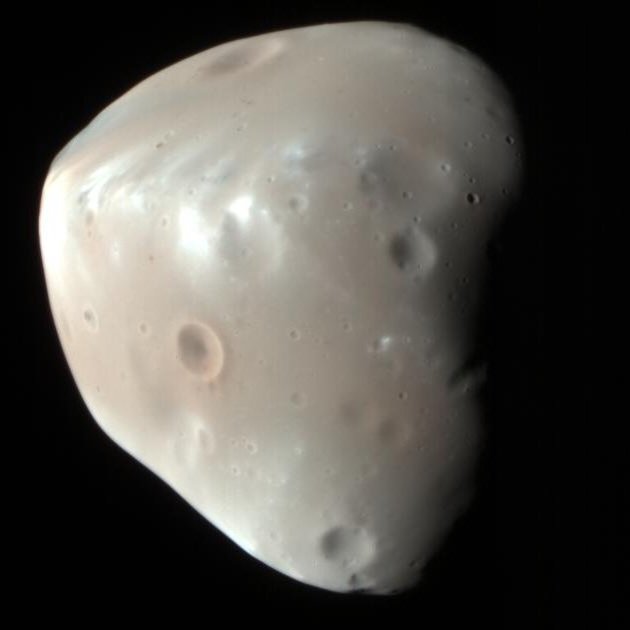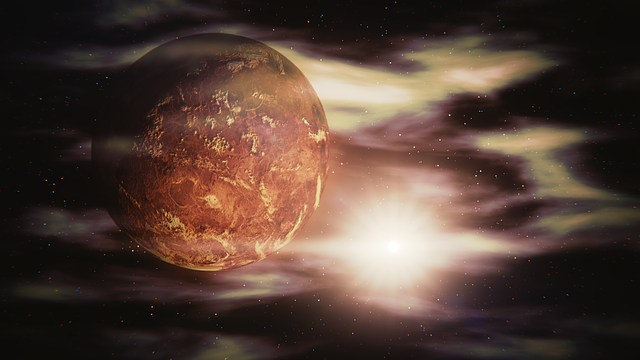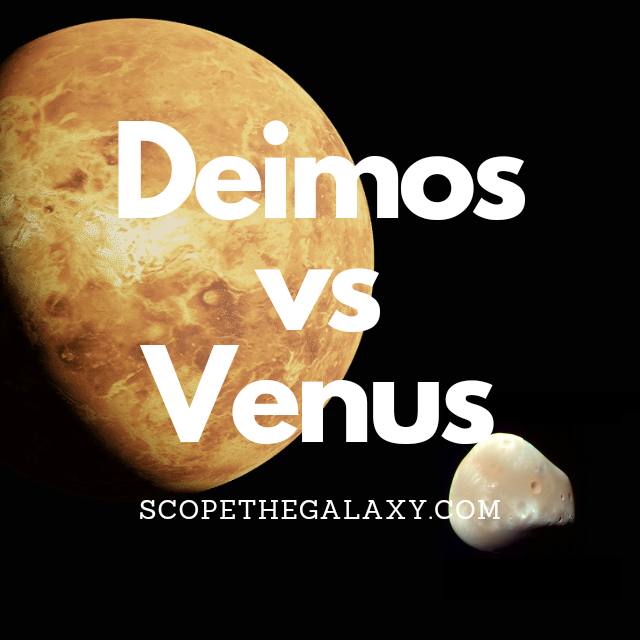*This post may contain affiliate links. This means we may make a commission if you purchase an item using one of our links*
The main differences between Deimos and Venus are that Deimos is a natural satellite while Venus is a terrestrial planet, Deimos is very small, coming in at 12.4 km while Venus is the second largest rock based planet with a diameter of 12,104km, and Venus has an atmosphere 90 times the thickness of Earth while Deimos has not atmosphere.
There various other differences between these two entities so, continue reading if you want a more detailed look at what both these bodies are, along with their simlilarities and differences below.
What Is The Moon Deimos?
Table of Contents

Deimos is the smaller and outermost of the two moons of Mars, named after the Greek God of dread and terror (the brother of Phobos). This satellite was also discovered by American astronomer Asaph Hall just five days before Phobos (12th August 1877).
Scientists like Johannes Kepler had put forward theories for the existence of these moons many years before they were discovered. Their calculations were based on the fact that the planets on either side (Earth and Jupiter) possessed one and four moons, respectively.
Still, none were discovered until the 19th century. One of the main reasons for this is that the tiny size of Phobos and Deimos, combined with an exceptionally close orbit to their planet, means that the glare of Mars often obscures our view of them.
Phobos measures just 15 x 12 x 11 km and completes an orbit of Mars once every 30 hours.
This tiny moon is also a heavily cratered landscape shaped by the impact of asteroid collisions over time. However, the material thrown up from these impacts doesn’t appear to have landed back on the moon’s surface as it usually would. This could be because the lack of gravity on Phobos allowed the ejected material into space.
The surface gravity on Deimos is just 0.003 m/s^2 (compared to 9.807 m/s^2 on Earth), which means the average gravitational pull of Deimos is only 0.003 m/s. With only 1/2500th of Earth’s gravity, you would need a tether to walk on this rocky moon, or every step would put you at risk of achieving escape velocity and launching yourself into space.
The composition of Deimos is similar to Phobos, suggesting that it might also be a captured asteroid. Its surface is very dark gray and has an albedo of around 0.07, meaning it reflects just 7% light (about half of the light Earth’s moon can reflect).
What Is The Planet Venus?

Venus is the 2nd closest planet to the Sun and is often regarded as Earth’s sister planet. It’s very close to our Earth in size where its diameter is 12,104km. This is just over 600km less wide than our home planet.
Unlike all the planets further outside the Sun’s orbit, Venus and even Mercury have no moons orbiting it. The most probable reason for this is due to its closer proximity to it, which means that smaller objects orbit the Sun as opposed to Venus.
Venus is also the hottest planet in our solar system where its surface temperature is 475 degrees Celsius. This is due to a number of factors, like the thicker atmosphere, close proximity to Sun, the reasons for which have been explained in more detail here.
It’s core is hot too, similar to that of the ice giants and Earth, where it stands at 5,200 degrees Celsius.
As a result of this thicker atmosphere, Venus is also able to reflect a lot more of the light the Sun projects at it, making it both the hottest and brightness planet in our solar system. This is why for the longest time, and even till this day Venus is often referred to as the morning or evening star.
The thicker atmosphere is mostly compromised of carbon dioxide, and thick clouds of sulfuric acid. This does result sulfuric acid rain on the planets surface, which of course is very corrosive.
Being so close to the Sun also mean its orbital cycle is much shorter. It takes Venus 225 days to complete a full cycle, on the contrary a single day is actually longer than this where it takes around 243 days for a full rotation around its axis.
This is partially down to its distance from the Sun and the thick atmosphere surrounding this terrestrial planet. The axial tilt on Venus is also different from the other planets in our solar system where it is practically straight at 3 degrees.
All in all this is certainly one of the most interesting planets in our solar system and in many peoples eyes, could very well have supported life in the past based on how close its shape and size is to that of Earth.
Similarities Between Deimos And Venus
Deimos and Venus do have their odd few similarities, which in this case includes the below:
- Both have a rocky surface.
- Both are part of the same solar system.
- Both have no rings surrounding them.
- Neither have plate tectonics.
- Neither have other moons orbiting them.
- Neither bodies have a magnetic field.
Differences Between Deimos And Venus
As for the differences between the two, they include the below.
- Deimos orbits Mars whilst Venus only orbits the Sun.
- Venus is a spherical shape while Deimos is not.
- Venus is a terrestrial planet whilst Deimos is a terrestrial based natural satellite.
- Venus has a diameter of 12,104km whilst Deimos has a diameter of 12.4km.
- Deimos has no atmosphere whilst Venus has the thickest atmosphere amongst the terrestrial planets, where it is 90 times the thickness of Earth’s consisting of 95.32% carbon dioxide, 2.7% nitrogen, 1.6% argon and 0.13% oxygen
- A day on Deimos takes 30 hours whilst a Venus day takes 243 days.
- It takes Deimos 30 hours to orbit Mars and around the Sun in 687 days whilst Venus orbits the Sun in 225 days.
- Deimos’ temperature ranged between -4 to -112 degrees Celsius whilst Venus has has an average temperature of 475 degrees Celsius which also makes its the hottest planet in our solar system
- Venus’ density is 5.24 g/cm³ whilst Deimos density is 1.47 g/cm³.
- Venus’ mass is 4.867 × 10^24 kg whilst Deimos’ mass is 1.4762 × 10^15 kg.
- Deimos’ gravitational strength is 0.003 m/s² whilst Venus’ is 8.87 m/s².
- Deimos is tidally locked to Uranus whilst Venus is not tidally locked to any entity
Summary
As a whole Venus and Deimos barely share any real commonalities besides their general rocky exterior and being a part of the same solar system.
Whether it be in regards to size, mass, atmospheric composition, gravitational strength, physical shape and more, Venus and Phobos are worlds apart.

